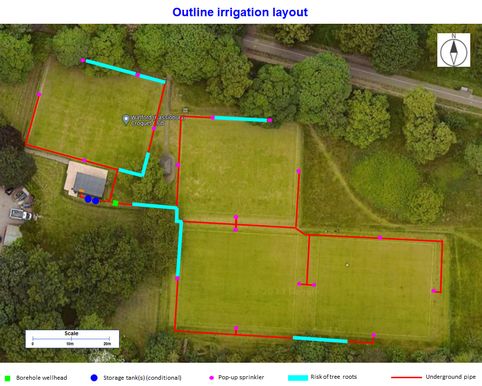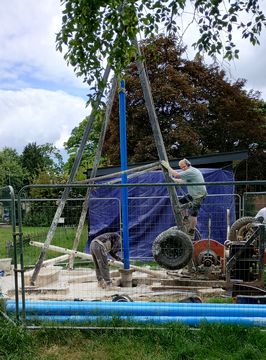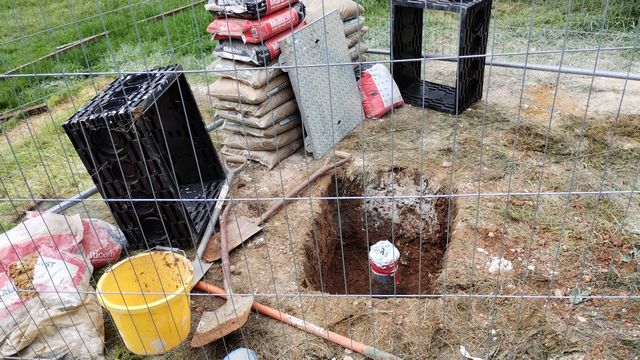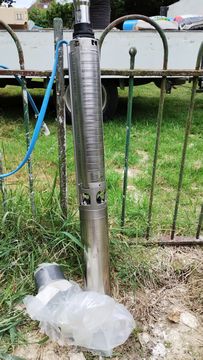Click on images for an enlargement
Summer/Autumn 2022
Investigation begins into the feasibility, cost and options for an automatic irrigation system. A review of boreholes
in the general area suggests that using a borehole at the club instead of mains water would be preferable on
environmental grounds, and although it would entail a higher capital cost the pay-back in terms of saving on water bills
should be within about 10 years at current mains water tariffs.
Information and advice about irrigation system design options is obtained from several other croquet clubs with
irrigation systems, which are all very willing to share the information.
Written confirmation is obtained from both Affinity Water and the national Environment Agency that they have no
objections to the use of a borehole for water supply at our location, and that for our expected consumption volume
(under 20m3 per day) an extraction licence is not required.
Plans for an irrigation system at the club are developed. The system would be funded from a combination of existing
club funds and a campaign to obtain some grants and donations.
June 2023
A hydrogeological survey is commissioned for a possible borehole to supply the water. The survey reports that the local geology is favourable, with underlying chalk that should
facilitate an ample supply of water with the water table expected at a depth of 15 to 20 metres.
August 2023
Tenders are invited from a selection of borehole contractors.
September 2023
The winning bidder is selected: Smith & Webb, a local firm.
November 2023
Approval for the installation of an automatic irrigation system at the club is agreed by Watford Borough Council,
subject to formal planning permission. The agreed project includes digging a borehole and the installation of
above-ground storage tanks if these are also required, though the latter will depend on the water supply available from
the borehole.
December 2023
An application for planning permission is submitted, and published by the Council.
Some local residents make a formal objection to the proposal on the grounds that the pop-up sprinklers will make too much
noise. The proposal therefore requires a full Council planning meeting for consideration.
Tuesday 6th February 2024
The objectors and the club each have an opportunity to make representations about the project at a Council planning
meeting. The club points out that years ago the Council itself installed an automatic irrigation system at the bowls club
nearby in the park, with sprinklers used routinely at 4am, and there have never been any complaints about the noise.
The Councillors agree
at the meeting
that our project can go ahead, but subject to the restriction that the sprinklers may not be used between 11pm and 7am.
Thursday 8th February 2024
The written planning approval is received from the planners with a couple of stipulations: that the work cannot start until there is also a
Tree Protection Plan, and that there is adequate noise installation for the borehole pump.
February 2024
A Tree Protection Plan is developed and discussed with the planners, and
evidence is collected to demonstrate that the borehole pump will be completely inaudible in use, but approval requires
submission of a further formal Discharge of
Conditions planning application.
Monday 15th April 2024
Acceptance of the Discharge of Conditions planning application is received, and work can finally proceed.
Thursday 30th May 2024
Work on drilling the borehole starts.
Use the buttons below each photo to step through the set, or to cycle through them all automatically.
Monday 3rd - Friday 7th June 2024
The going is quite slow at first through a layer of gravel below the top metre of soil, but the expected chalk
strata is reached after about 9m and then progress is much more rapid. The water-table is reached at a depth of 14m,
consistent with the 15 to 20m predicted in the hydrogeological survey. The plan is to drill about 30m below the
water-table.
Monday 10th - Tuesday 11th June 2024
Drilling continues with quite rapid progress through the chalk. The area around the borehole turns white with
chalk slurry!
Wednesday 12th June 2024
Drilling is completed and a 5" diameter perforated plastic pipe is inserted into the borehole.
Thursday 13th June 2024
The drilling rig is removed and the manhole pit is prepared.
Friday 14th June 2024
The borehole supply is tested. After an hour of pumping at around 3m3/hour the water-table dropped only 60cm - a healthy supply.
It started very chalky but became steadily clearer over time, which is quite normal.
The next stage is to finalise the details of the irrigation system design to suit the new water supply, and specifically the flow rates and pressures, so that an appropriate model of borehole pump can be selected and installed.
Tuesday 2nd July 2024
The Grundfos pump is installed at the bottom of the borehole.
Wednesday 10th July 2024
The trenches for the pipes and cables are dug around all the courts, and work starts on laying the pipes and
cables in them.
Thursday 11th July 2024
The pipes are installed and connected up, and work starts on digging pits for the Rainbird pop-up sprinklers, connecting up
the electrics, testing the electrical connections, and then refilling the trenches, apart from above the pipe
connections.
Friday 19th July 2024
The borehole pump is connected up to the pipe network, the pressure vessel is installed inside the pavilion, and the
network is checked for leaks so that the trenches around all the pipe connections in the trenches can then be refilled
as well.
Saturday 20th July 2024
The sprinklers are tested, and work starts on connecting the cables to the Rainbird controller.
August 2024
Automatic late-evening irrigation is started, and runs between 8pm and 11pm. The sprinkler settings and schedules are fine-tuned.
The courts are fertilised and watered.
Several club members help to clear way the large amounts of stones and soil left behind by the trenches after they were refilled.
The pressure vessel inside the pavilion is boxed in and the box is painted.
Friday 30th August
1200 litres of fine loam topsoil are delivered to fill the top inch of the ground above the trenches in preparation
for re-seeding, and the re-seeding is started.
Tuesday 17th September
The club holds a 'sprinkler party' to celebrate the successful completion of the project. The courts are now green and uniformly
paced, and they can now be cut to 5mm on a regular basis.

 Mary Rose
Mary Rose
 Longman Cup
Longman Cup
 Anderson Shield
Anderson Shield
 Beds & Herts League
Beds & Herts League
 AC Regional league play-off
AC Regional league play-off
 AC Friendly inter-club
AC Friendly inter-club
 AC Tour
AC Tour
 GC Inter-Club Championship
GC Inter-Club Championship
 GC Inter-Club (Murphy) Shield
GC Inter-Club (Murphy) Shield
 GC Open League Western Area
GC Open League Western Area
 GC B-Level League Central & West Area
GC B-Level League Central & West Area
 GC B-Level League final
GC B-Level League final
 GC Handicap League Western Area
GC Handicap League Western Area
 GC Handicap League play-off
GC Handicap League play-off
 GC 4-Club Trophy
GC 4-Club Trophy
 GC Friendly inter-club
GC Friendly inter-club
 EACF AC Club Champions Tournament
EACF AC Club Champions Tournament
 Open AC Midweek Advanced
Open AC Midweek Advanced
 Open AC Midweek B-Level Advanced
Open AC Midweek B-Level Advanced
 Open AC One-Day
Open AC One-Day
 AC Level Advanced
AC Level Advanced
 AC B-Level Advanced
AC B-Level Advanced
 AC Handicap
AC Handicap
 AC All England Handicap
AC All England Handicap
 AC High Handicap
AC High Handicap
 AC Charity One-Ball
AC Charity One-Ball
 AC One-Ball (Sep)
AC One-Ball (Sep)
 AC One-Day (Sep)
AC One-Day (Sep)
 AC One-Day Doubles (Aug)
AC One-Day Doubles (Aug)
 SC One-Day (Jul)
SC One-Day (Jul)
 Open GC
Open GC
 Open GC A-level
Open GC A-level
 Open GC B-Level
Open GC B-Level
 Open GC C-Level
Open GC C-Level
 Open GC D-Level
Open GC D-Level
 Open GC Handicap Doubles
Open GC Handicap Doubles
 GC Level Play
GC Level Play
 GC All England Handicap
GC All England Handicap
 GC Handicap Singles
GC Handicap Singles
 GC Intermediate Handicap
GC Intermediate Handicap
 GC High Handicap
GC High Handicap
 GC Handicap Doubles
GC Handicap Doubles
 GC Progressive Doubles (Apr)
GC Progressive Doubles (Apr)
 GC Progressive Doubles (Sep)
GC Progressive Doubles (Sep)
 GC One-Day Singles (Jun)
GC One-Day Singles (Jun)
 Mary Rose
Mary Rose
 Longman Cup
Longman Cup
 Anderson Shield
Anderson Shield
 Beds & Herts League
Beds & Herts League
 AC Regional league play-off
AC Regional league play-off
 AC Friendly inter-club
AC Friendly inter-club
 AC Tour
AC Tour
 GC Inter-Club Championship
GC Inter-Club Championship
 GC Inter-Club (Murphy) Shield
GC Inter-Club (Murphy) Shield
 GC Open League Western Area
GC Open League Western Area
 GC B-Level League Central & West Area
GC B-Level League Central & West Area
 GC Handicap League Western Area
GC Handicap League Western Area
 GC Handicap League play-off
GC Handicap League play-off
 GC 4-Club Trophy
GC 4-Club Trophy
 GC Friendly inter-club
GC Friendly inter-club
 Open AC Midweek Advanced
Open AC Midweek Advanced
 Open AC Midweek B-Level Advanced
Open AC Midweek B-Level Advanced
 Open AC One-Day
Open AC One-Day
 AC Level Advanced
AC Level Advanced
 AC B-Level Advanced
AC B-Level Advanced
 AC Handicap
AC Handicap
 AC All England Handicap
AC All England Handicap
 AC High Handicap
AC High Handicap
 AC Charity One-Ball
AC Charity One-Ball
 AC One-Ball (Sep)
AC One-Ball (Sep)
 AC One-Day (Sep)
AC One-Day (Sep)
 AC One-Day Doubles (Aug)
AC One-Day Doubles (Aug)
 National GC C-Level (7+) Series Final
National GC C-Level (7+) Series Final
 EACF GC Club Champions Tournament
EACF GC Club Champions Tournament
 Open GC
Open GC
 Open GC A-level
Open GC A-level
 Open GC B-Level
Open GC B-Level
 Open GC C-Level
Open GC C-Level
 Open GC Handicap Doubles
Open GC Handicap Doubles
 GC Level Play
GC Level Play
 GC All England Handicap
GC All England Handicap
 GC Handicap Singles
GC Handicap Singles
 GC Intermediate Handicap
GC Intermediate Handicap
 GC High Handicap
GC High Handicap
 GC Handicap Doubles
GC Handicap Doubles
 GC Progressive Doubles (Apr)
GC Progressive Doubles (Apr)
 GC Progressive Doubles (Sep)
GC Progressive Doubles (Sep)
 GC One-Day Singles (Jun)
GC One-Day Singles (Jun)
 GC Grass Roots
GC Grass Roots




